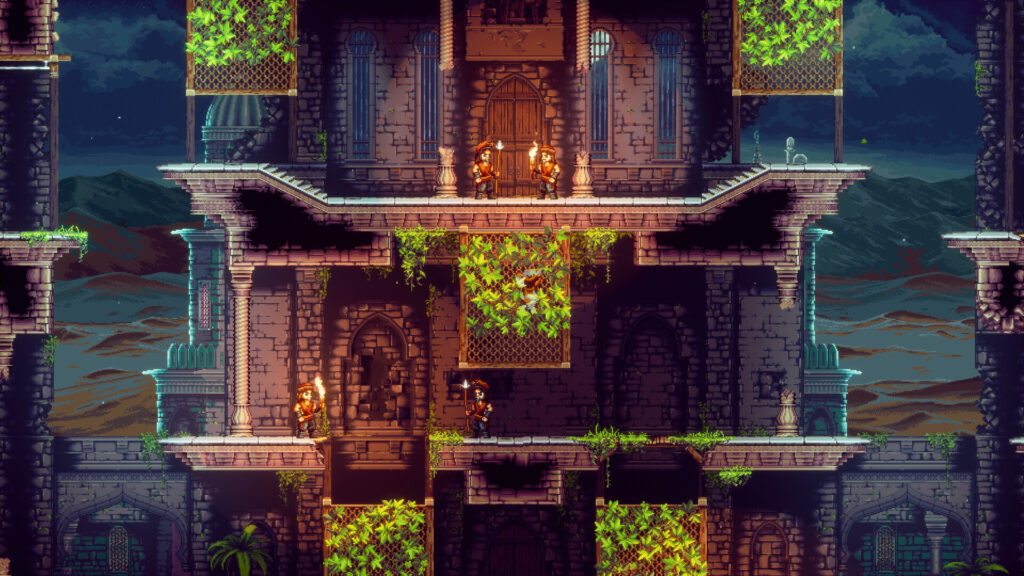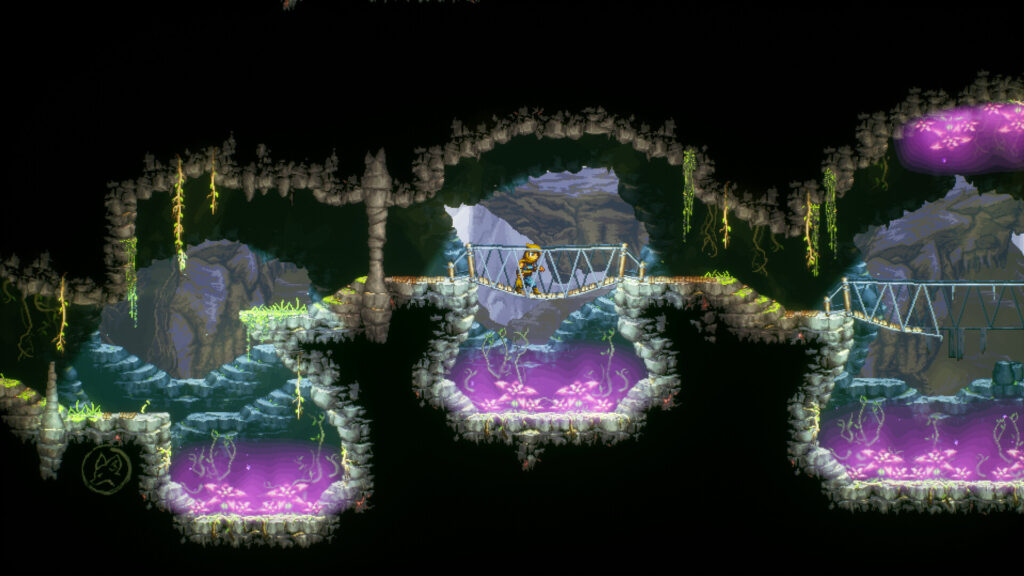There’s a certain magic in a Metroidvania that dares to break its mold. The Siege and the Sandfox is not your typical action-driven, combo-heavy side-scroller. Instead, this is a game that whispers instead of shouts. It trades the frantic energy of combat for the deliberate pace of stealth, and the result is something that stands apart in a genre full of imitators. It’s bold, distinct, and for the most part, it works. But it still feels like a diamond in the rough, that should not have been released … just yet.
A Kingdom Buried in Secrets
From the moment you step into the sun-drenched city of Urfah, it’s clear that The Siege and the Sandfox is a game built on atmosphere and narrative layering. The story unfolds with elegance, weaving political betrayal, ancient secrets, and the creeping dread of war into a tightly spun narrative. Its setting and tone reminded me a lot of how Bastion operated. Heavy on the narration, heavy on the story, all to set a particular tone, with a protagonist that feels mysterious, yet recognizable. You play as the illustrious Sandfox — a nimble figure wrongfully accused and thrown into the depths beneath the city — who now must ascend from exile, uncovering the truth one hidden corridor at a time.
What makes the story so compelling isn’t just the premise, but how it’s told. Environmental storytelling is king here. The architecture of Urfah tells its tale, from sunken tombs to crumbling aqueducts. NPCs don’t overload you with exposition — they hint, they warn, they remember. That said, if you can get them to talk, and that’s not about handing them the right items, sadly. The plot feels alive, not forced, and it complements the slow-burn pacing of the stealth-first gameplay. Think Mark of the Ninja meets Splinter Cell combined with Hollow Knight and Bastion. Yes? All aboard? Let’s dive a bit deeper.
Stealth as the Heart, Not a Gimmick
Stealth is where The Siege and the Sandfox truly stake their claim. While most Metroidvanias focus on fast traversal, flashy combat, or overwhelming swarms of enemies, this game pulls back — you are not a warrior, you are a shadow. There is no direct combat; if you’re seen, your best option is to run. The tension this creates is what drives this game. It forces you to rethink your options.
You’ll sneak past guards, eavesdrop from ledges, and use parkour to navigate rooftops and rafters. Controls are sometimes a bit crude, with most of the time, responsive movement and climbing mechanics that reward precision and timing. But there also lies the downside. The jumps often require such precision that it’s easy to miss a pole swing or ledge, which means lots and lots of replayable jumps. Another aspect, next to near-perfect platforming skills, is the noises you make. Sound plays a crucial role — both yours and your enemies’. Sprinting too often? You’ll attract attention. Misjudge a drop? You’ll give yourself away. It’s a constant dance between speed and silence. This focus on stealth over fighting is a refreshing contrast to genre staples like Hollow Knight or Axiom Verge, where combat is a central pillar of the game. Here, every enemy is a puzzle rather than a punching bag. It brings to mind Mark of the Ninja, but with the exploration depth and environmental complexity of the Castlevania series (like Order of Ecclesia or Portrait of Ruin).
A Metroidvania at its Core — With a Twist
While stealth is the primary hook, the game doesn’t forget its Metroidvania DNA. The world is sprawling, interconnected, and full of secrets. Gated areas require new abilities or clever use of movement skills to access. You’ll return to old places with new perspectives, revealing hidden routes and narrative breadcrumbs that add new context to earlier events. The developers added a non-linear design that encourages exploration, but often feels overwhelming. What should have been a clever map design filled with subtle environmental cues guiding you through the game without hand-holding often feels like running around to find the ‘next’ objective. It’s clear that the developers tried to make it about more than backtracking, but recontextualizing. What was once a dead end is now an opportunity, a revelation, or a shortcut – but without a specific waypoint, a working way to fast travel (it was bugged during my playthrough). Objectives do feel like part of a bigger plot and often lead to NPCs moving throughout the map, but I frequently found them either bugged and unable to talk, or no way to get to the next plot point.
Visuals, Sound, and a Few Cracks in the Stone
Visually, the game is striking. It blends rich pixel art with dynamic lighting and subtle depth-of-field effects, giving every scene a sense of dimension. It almost felt like playing Prince of Persia in a pixel art style, with the color palette shifts as you move between zones — warm tones dominate the upper city, while the deeper levels are bathed in eerie blues and sickly greens. Something that also worked for Shovel Knight and consorts, so it’s clear that the developers knew what they were doing. Same goes for the music, which changes about your presence, swelling when danger looms and quieting to near silence as you slink through shadow.
Of course, no game launches without a few hiccups, but with the Siege and the Sandfox, it feels like more than a few cracks. I can overlook some technical quirks that may affect the experience, since it has been a challenging process to get this game to boot up. But, like I mentioned before, I found a whole bunch of glitches and bugs that made my game unplayable. I’ll create a short list, which will show why I chose to deduct a lot of score points in this game, since the potential is enormous.
Bugs/Glitches:
- NPCs would often not trigger a quest or conversation with me, which resulted in reloading the last checkpoint until it would trigger.
- I fell through both walls and floors more than I could count. This led to game-breaking map jumping, either making me stuck on the wall/floor or launching me through the air till I got stuck again. This needed to be fixed with another checkpoint reload, and I lost progress.
- Fast Travel wouldn’t activate for me, even though I got a few fast travel points unlocked; the map locked me out of traversing to another point.
- Just before I worked on this review, the game made me drop to a point in the map I couldn’t have reached with my current gear, but gave me a new save point there. There was, however, no way to return to my original point of play, since I hadn’t unlocked a piece of equipment needed to scale what I needed to scale (I don’t want to spoil it). This rendered my save game unplayable, resulting in the loss of all my progress. Which means I will revisit once the very rough patches are patched out.
Conclusion
So to conclude, The Siege and the Sandfox doesn’t just follow the Metroidvania formula — it tries to redefine it from a new angle. It’s a game that asks you to slow down, to think before you move, and to savor the journey rather than rush to the boss room. Its story is compelling, its world beautifully realized, and its mechanics are a daring twist on a beloved genre. However, in its current buggy and glitchy state, it’s almost impossible to complete, let alone 100% complete. I will revisit it once the game is more polished and less rough around the edges, since I feel there is a diamond underneath all this dust and could have easily been a new favorite of mine (with an 8 instead of a 6).






